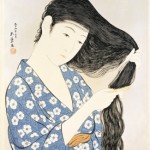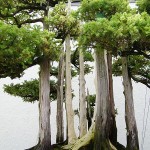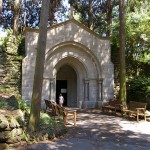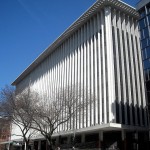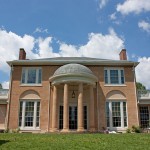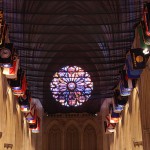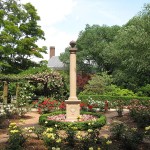That’s right: Wikimedia DC is hiring for a five-month contract position to manage the Wikipedia Summer of Monuments program. Summer of Monuments is an outreach campaign modeled off of Wiki Loves Monuments, a photography contest successfully carried out in the United States in 2012 and 2013. The goal of Wiki Loves Monuments was to get pictures of historic sites, recognized on the National Register of Historic Places. Two years of contests resulted in 30,000 pictures uploaded, enhancing Wikipedia’s coverage of these historic places. We got the idea for Summer of Monuments after seeing that despite two years of these contests, the contest benefits some parts of the country more than others. That is to say, 30,000 uploads later, there are still states where fewer than 50% of the registered historic sites have pictures on Wikipedia.
Most of these states are in the South, including Arkansas, Oklahoma, Kansas, North Carolina, Mississippi, Missouri, Kentucky, Georgia, Tennessee, and Louisiana. To get the pictures of the sites we need, we will carry out a campaign that involves reaching out to county historical societies, individual photographers, and contributors on Wikipedia. The campaign will extend nationwide in September, comparable to the Wiki Loves Monuments contest held over the past two years. Your job will be to help develop and execute this campaign, supplementing the efforts of an enthusiastic online community.
Job description:
Wikimedia DC is looking for a project manager to run its Wikipedia Summer of Monuments campaign in 2014. This will be a paid contract position that will begin in May and end in mid-October. This position is based in Washington, DC, but some travel (with expenses paid) will be required as part of the job.
Duties:
- Outreach to county historical societies and individual volunteers to contribute photographers
- Coordination with WikiProject NRHP
Requirements:
- 1–2 years project management or field organizing experience
- Excellent interpersonal and collaboration skills, a demonstrated aptitude for building professional relationships, including through online communications
- Strong organizing skills, capable of operating with little direct supervision
- Must provide own laptop computer
Preferred, but not required:
- Strong preference for candidates with experience on Wikimedia projects, including Wikipedia
- Regardless of Wikimedia experience, an ability to categorize photographs according to a set of standard criteria
- Photography experience, owning a professional-grade camera
- A strong sense of logistics and the ability to interpret visual data (namely maps) would be helpful
- Demonstrated interest in history and historic places
- Existing relationships with historical societies, particularly in the Southern United States
To apply:
To apply for the position, please e-mail a cover letter and résumé to James Hare at [email protected]. We will contact you if we are interested in further consideration of your application. No phone calls, please.
More information:
- About Wikimedia DC
- Wikimedia Foundation grant proposal funding the program, including the job position
- Wikipedia article on Wiki Loves Monuments
- Progress report maintained by WikiProject NRHP
- Press release announcing the results of Wiki Loves Monuments 2013.
 Lasting the whole month of September, Wiki Loves Monuments—USA is part of an international Wiki Loves Monuments
Lasting the whole month of September, Wiki Loves Monuments—USA is part of an international Wiki Loves Monuments
competition that anybody with a camera and internet connection can join in on. Focused on improving the number and quality of photos related to historic monuments and places, the Wikipedia community started a photo contest in 2010 in the Netherlands. The result was 12,500 freely licensed images of monuments that anybody can use for any purpose. In 2011, 18 countries participated in the contest resulting in 5,000 participants submitting more than 165,000 images.
This year, 2012, the contest has come to the US and will focus on sites on the National Register of Historic Places (NRHP) which volunteers have organized on Wikipedia by state and county, including other sites chosen by local Wiki Loves Monuments coordinators.
Every participating country will put together a national contest with partners, rules, events, and winners. Then every national contest will nominate some of their winning pictures for the international contest. An international jury will award extra prizes to the best images from all participating countries. The grand prize this year will be a trip to Hong Kong!
Any participation is welcome: from uploading a single image to spreading the word about the contest, to even becoming
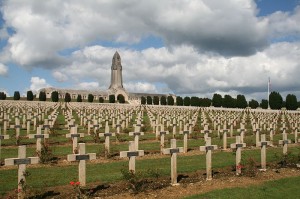
A winner of Wiki Loves Monuments 2011:
The cemetery with Douaumont ossuary (Verdun), France (Meuse, Creative Commons Attribution-Share Alike 3.0 Unported license.).
sponsor.
In the Washington, D.C. area we are lucky to have a cornucopia of historic buildings, statues, and towering monuments that are all ripe for the photographing. Take an afternoon, or even just a few seconds walking home from work, to take a picture of an old building or a statue and upload it in September to enter it into the contest. Take a tour with friends or family, or go on a solo hike around town. Participating is super easy. Just check out the already compiled list of historic places on Wikipedia at http://en.wikipedia.org/wiki/List_of_RHPs#Current_listings_by_state_and_territory and choose where you want to go.
On September 8th a group of energetic Wikipedians went forth on a photo scavenger hunt called Wikipedia Takes DC and took a plethora of great photos for Wiki Loves Monuments despite inclement weather in the afternoon!
Throughout September we will be having several uploading/meetup gatherings at the Starbucks on Dupont Circle so feel free to swing by and join the party!
Lisa Marrs, Outreach & Program Coordination, Wikimedia DC
]]>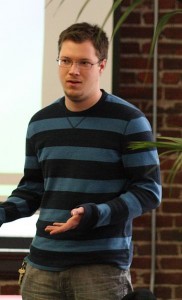
Dominic McDevitt-Parks during Campus Ambassador training
GLAM, the Wikimedian acronym for Galleries, Libraries, Archives, and Museums, equates to more than just the institutions categorized by the letters. It also encompasses the merging of communities. On August 13, 2012, Dominic McDevitt-Parks, the wikipedian-in-residence at the National Archives and Records Administration since May 2011, gave a talk labeled “Cultural Institutions and Wikipedia: a Mutually Beneficial Relationship” on what a symbiotic relationship between Wikipedia and a cultural institution can look like.
Introducing Dominic was Wikimedia DC’s own Kristin Anderson, who described the Wikipedian community to the Library of Congress audience as “the only people who like information as much as library catalogers are Wikipedians…Wikipedia and the Library of Congress share Thomas Jefferson’s dream of…information for everyone.”
In his talk, Dominic broke down how cultural institutions and Wikipedia can work together to form mutually beneficial partnerships. If the goal of an institution is to encourage the use of its materials, Wikipedia is a natural fit, being the 5th largest internet site. Dominic gave numbers and a visual to put it all into perspective. The National Archives website gets 17 million views a day. In contrast, a very conservative estimate of the number of views that the Wikipedia articles that use National Archives material receive every day is well over a hundred million. This isn’t pointing at a problem, but at a fact, and one that can lead to a solution for many institutions; Wikipedia provides a ready-made platform to spread not only information through articles, but also to put up source documents on sister projects Wikisource and Wikimedia Commons.
The National Archives takes full advantage of this online volunteer community by encouraging local Wikipedians to come to scan-a-thons and the online Wikipedian community to tag the uploaded scans and transcribe the text documents on WikiSource. Due to the tireless efforts of many Wikipedians, well over a hundred thousand documents have been scanned in and transcribed.
Even if the question of whether or not Wikipedia is a reliable source is raised, if a person sees a mistake on Wikipedia, it is up to him or her to make the change. Unlike other encyclopedias or collections, if people find a mistake on Wikipedia or one of its sister projects, they can correct it. There is a large community of editors watching to make sure the information is as accurate as possible. Recognizing that its own information is not infallible, the Archives has created a feedback page on its own website for people to post mistakes and corrections on.
Dominic summarized the role of a Wikipedian-in-residence nicely: the Wikipedian-in-residence provides access to the institution to the Wikipedia community and vice versa, which brings about not only community engagement, but also culture change within the institution itself, making it more open and accessible to the layperson. This is change which the National Archivist David Ferriero heartily embraces and encourages, in the words of one blogger during the National Archives ExtravaSCANza in 2011, “If it’s good enough for the National Archivist, it’s good enough for you.”
Lisa Marrs, Outreach & Program Coordination, Wikimedia DC
]]>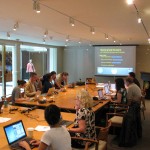
Editing away in the Luce Center
Sculptures dot the hallways and rooms alongside works of art representing more than 7,000 artists in the National Historic Landmark, the Smithsonian American Art Museum. Within the many-tiered Luce Center 15 people gathered; their quest, to embark upon an edit-a-thon focused on 30 different masterpieces hand picked by the museum Director, Elizabeth Broun. Before the program began, she spoke to everyone about how putting the museum’s art on Wikipedia is one of her overarching “subversive goals”.
Following a tour and a scrumptious lunch provided by the museum, everyone filed into the Luce Center conference room and started working. Many participants had never edited Wikipedia, but it wasn’t long before they whetted their first tooth. From artist Childe Hassam to a created article on the Nakoda Wikipedia everybody contributed something to the world’s largest online encyclopedia.
Georgina Goodlander, the Web and Social Media Manager at the Smithsonian American Art Museum and the wonderful lady without whose efforts this event would not have been possible, has now got an appetite for Wikipedia, she says. A definite success, she plans to make Masterpiece Museum a series instead of a one-time event. Some meetings may even take place on a Saturday to catch those who cannot leave work during the week.
To see the images uploaded during the event, click here. To see articles created or improved during the event, click here.
Lisa Marrs, Outreach & Program Coordination, Wikimedia DC
]]>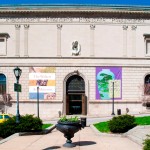
Charles Street entrance to the Walters Art Museum.
Down Charles Street in Baltimore, Maryland sits a museum basking in the hot summer sun like a contented cat, right across from the gloriously green, statue-populated, and many-fountained grounds of Johns Hopkins University. Within the museum’s cool, white marble halls and rooms rest thousands of art treasures, from ancient American statues to canvasses from the mid-1900s. This is the Walters Art Museum, completely free to the public, and the site of ArtBytes, a hackathon that debuted the weekend of July 27, 2012.
Hackers from as far away as New York came together with museum staff to figure out how to better the museum experience in a competitive, yet collaborative atmosphere. The teams worked through the weekend and most of them arrived at the ending presentations with nearly completed, if still rough, products. There was team Time Machine’s mobile app that could recognize a work of art and then show that work’s original color or an xray of that work depending on the images and information the museum has in storage. Team Pez-Head created a way to do 3D modeling of sculptures and then print them out in rather excellent detail to make art more accessible by making it “touchable”. Both Team Schrodd0n and WalTours made different kinds of maps for mobile devices for the Walters Art Museum to help visitors navigate exhibits. Dave Raynes, a team of one, worked on making the data shored up in the Walters databases more easily available to software, which was a great help to many other groups. Badgify the Walters was all about putting up QR codes around the museum for kids to find and scan to collect points by doing quizzes on the art works which would eventually culminate in collecting badges on a profile online.
Although all groups ‘won’ the competition and each received $500, the judges managed to pick out two favorites to shower $1000 on. The first was
“Put Art in its Frame,” a mobile application where you can choose what time period the exhibit is in and then see all the significant world events that happened during that time period. The second was “Tanzaku,” a mobile application taking from the Japanese idea of writing notes on strips of paper (tanzaku) and hanging them up for all to see, which is an idea already in effect in the Hashiguchi Goyo “Beautiful Women” exhibit, where visitors write their own tanzaku and put them up on wires. The mobile app is a way to leave comments on art pieces and exhibits, as well as on the museum itself, with the potential to be connected to various social networking sites. All of this provides a way to potentially go on a tour with absent friends and explore how various pieces of art have touched different people.
So many amazing projects came out of this hackathon, sprung from the creative minds and intense will of their creators. Tapping into this pool of talented people, the Walters Art Museum ultimately benefited, providing an example other Galleries, Libraries, Archives and Museums may follow. The museum is not only enterprising in terms of calling forth capable people to use their talents and grow new abilities, but it also furthers its own goals by tapping into existing projects such as Wiki Loves Monuments, an event coming up in September where people all over the globe will sally forth to take pictures of public objects of historic and/or artistic value and upload those pictures onto Wikimedia Commons, both to increase the stock of public domain photos and to enter their photos in a contest. The Walters’ Wiki Loves Monuments is accepting pictures now of public artworks all over Baltimore as an extension of their Public Property exhibit (although note that only pictures submitted to Commons during the month of September are eligible for the worldwide contest).
Lisa Marrs, Outreach & Program Coordination, Wikimedia DC
]]>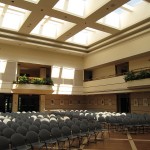
Photo courtesy of Gryffindor under the Creative Commons Attribution-Share Alike 3.0 Unported license.
The Austrian Embassy’s giant reception room was packed. Row upon row of quiet guests in formal evening attire sat beneath a wide, glassy sunroof allowing the last rays of the sun to soak quietly into the dim room. Even the people in blue and red in the paintings lining the walls seemed to be waiting. The stage was set and lit and an older woman with short, blonde hair took the microphone, “This is my last cultural event,” Andrea Schrammel, the Director of the Austrian Cultural Forum Washington, informed the waiting audience. Even though she had spoken these words several times before, it was much more real this time, as the Austrian government was calling her back to Vienna after four years in the United States.
After her brief introduction of the event, a musical duet by famed Jazz piano composer Michael Kahr and violin prodigy Barbara Helfgott, Wikimedia DC‘s own Nicholas Bashour, in a turquoise button shirt that matched the blues in some of the art around the room, took the stage as a sponsor of the event and told the expectant audience that this event is only the tip of the iceberg, that Wikimedia DC is active and looking for more opportunities to reach out to the international crowd.
Applauding, the people fell silent when Kahr, tall with a fitted black suit and mahogany hair feathering his neck, stepped out of the backroom alone and took the ready stage. Without preamble he sat down at the waiting piano and began. Soft and classical notes met strains of improvisation in a dizzying way as the last of the sunlight faded from the room and the only light came from the beams concentrated on the man and his piano.
After two songs, he finally arose, bowed to the applause, and addressed the audience saying how wonderful it was to be there that night and to introduce Barbara Helfgott as “the future of Austrian music”. She came striding out of the backroom in six inch sparkly white heels, sleeveless black dress that went to the top of the knees, and a brilliant smile, holding out her violin and bow as she crossed to center stage.
Nodding to the sound technician to her left and clenching the violin between her chin and shoulder, she smiled at Kahr and winked at the audience as the bada-tss of percussiondrums and other instruments began to throb from the speakers and wash out over the audience like the beginning ripples of a rising tide. Then Kahr joined in with the piano, moving back and forth on the seat, shoulders keeping the beat along with his fingers as they ran across the keys. Nodding and tapping her toes, Helfgott moved in, the first few notes screaming out from the violin like lost souls. The audience began to look restless, phones were brought out, someone left the room with fingers in her ears. Yet Helfgott smiled and turned to Kahr, nodding almost imperceptibly, and the real music began.

Austrian pianist Michael Kahr and Austrian violinist Barbara Helfgott, photo by Nicholas Michael Bashour, CC BY-SA 3.0
For forty or so minutes straight, Helfgott and Kahr coaxed wild and beautiful melodies from the piano and violin, intertwining and separating them from the background music thumping from the speakers. After finishing the first set, they returned for not one, but two encore performances. During the first encore, Helfgott introduced the next song, “I’m So Excited,” by taking the microphone and giving a short speech about how excited she was to be at the embassy, how excited the embassy people were to have her and Kahr, and she knew the audience was super excited, too. Then, Helfgott turned to the audience and said, “well, this concert is called From Mozart to Michael Jackson. There hasn’t been any Mozart, but, we have Michael Jackson,” after which she and Kahr played the finalist song: “Billie Jean” by Michael Jackson.
After the romping musical escapade during which Kahr shook his shoulders to the music and Helfgott danced as she played her violin, Helfgott and Kahr returned for a final encore, this time, a request from the audience. “Mozart, Mozart!” the audience chimed in, but, unfortunately, according to Helfgott, “Mozart did not really write a lot of pieces for piano and solo violin.” As a compromise, she played, on her own, a rendition of one of Mozart’s most famous and challenging arias, “Der Hölle Rache kocht in meinem Herzen” from the opera “Die Zauberflöte” (The Magic Flute).
After the concert, everyone broke for food and wine, and during the reception we had the opportunity to briefly interview these two great musicians.
Barbara Helfgott, with her amazing showmanship, got her start on the violin at the tender age of 5, and by 10/11, she was already winning contests and attending university classes for the musically gifted. After being turned away from philharmonics because “women can’t play the same as men,” she resolved to create her own philharmonic ensemble. And she did: the Rondo Vienna, a group of up to 25 women musicians that travels Europe and, in 2007, won the Austrian Show Award.
Although she doesn’t have a favorite location where she would love to play, she does want to play wherever there are “people who love music. There is a symbiosis between musician and audience: the musician expresses themselves through their music and the audience takes and gives back, in turn expressing themselves through listening.”
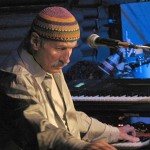
Joe Zawinul
Photo courtesy of Wikimedian, under the Creative Commons Attribution-Share Alike 3.0 Unported license.
Michael Kahr first became attached to jazz when he heard the music of Joe Zawinul, an Austrian-American jazz keyboardist and composer. With jazz, he says that “the music itself draws you in. It is a musical language, there are no definitive differences you can point to between Austrian, African, Australian, and American jazz even if there are some researchers now trying to find those differences.” And he has been all of those places in search of musical inspiration, studying jazz wherever he goes.
“When I was young, I knew I wanted to travel,” he added. He has visited America (the birthplace of jazz), Africa, the Middle East, and Australia in order to find traditional instruments, gather inspiration, and experience the music scene in those countries as well.
As the guests slowly trickled out from the embassy into the humid blanket of night with the orange glow of incandescent bulbs behind them, and those who live at the embassy climbed the stairs to their living quarters, no one had a cross word to say, or a regret for coming. Bridging cultures and languages, bringing people together to connect ideas, Wikimedia’s Embassy Outreach Initiative’s second event left everyone moon walking away with thrumming hearts and dancing minds.
Lisa Marrs, Outreach & Program Coordination, Wikimedia DC
]]>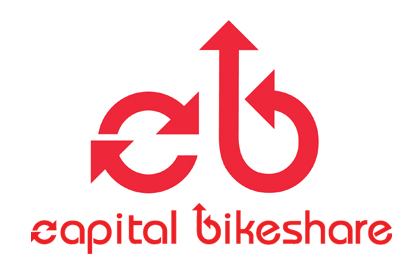 Wikimania’s coming to DC next week! With so much to do and see in this political, cultural, and economic center many of our guests might be overwhelmed. So leave a comment describing a spot in DC, be it a restaurant, museum, park, monument, street or library that either is your favorite, or, if you’ve never been in DC before, you are looking forward to visiting the most, and explain why that is. Let’s churn up some ideas so folks from outside the area can prioritize their to-visit list!
Wikimania’s coming to DC next week! With so much to do and see in this political, cultural, and economic center many of our guests might be overwhelmed. So leave a comment describing a spot in DC, be it a restaurant, museum, park, monument, street or library that either is your favorite, or, if you’ve never been in DC before, you are looking forward to visiting the most, and explain why that is. Let’s churn up some ideas so folks from outside the area can prioritize their to-visit list!
In the spirit of fun, we’re going to make this a contest based on the quality of reasoning behind why a place is your favorite.
]]>
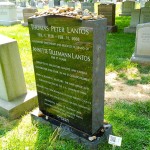
Grave of Representative Tom Lantos at the Congressional Cemetery, Washington, DC. Note the QR code.
Creative Commons Attribution-Share Alike 3.0 Unported license under Peter Ekman.
All the world’s a stage, and every prop, scene, and player conceals a story. On the way to work we pass by some statue or fountain that once tickled the imagination and now sits comfortable and unnoticed in its familiarity, and wonder what story lies behind it. Passing an eccentric neighbor’s cubicle and glancing at the sprinkling of medieval portraits adorning its walls, we briefly wonder just who Nostradamus actually was. With leaps in information technology, finding the answer can be as easy as pointing your smart phone at a little card.
Just in the past year QR codes have cropped up on walls and banners, on brochures and menus, linking customers with the appropriate smart phone application to websites about the advertised business or to nutritional facts on a menu’s dishes. Increasingly, institutions such as museums, galleries, and city governments realize the educational potential behind these codes. Wikipedia, with its crowd-sourced articles on millions of topics in hundreds of languages, is the most comprehensive source for articles about pieces of art or the history of a central park. The love child between these institutions and Wikipedia is QRpedia.
Just recently, the 205-year-old Congressional Cemetery became the world’s largest outdoor encyclopedia of American history. Sixty QR codes link visitors to the Wikipedia pages of such diverse people as Congressman Henry Clay, FBI Director J. Edgar Hoover, and Leonard Matlovich, America’s first openly gay serviceman. The Wikimedian behind this effort, Peter Ekman, explained why he chose a cemetery, not exactly the typical GLAM (Galleries, Libraries, Archives, Museums) outreach fare.
“It chose me,” he said. “Everything I wanted to do, the cemetery people were happy to oblige. Most of the article compilation work was already done by anonymous Wikipedians so most of the work was just printing out the codes and putting them up. It is cheap, inexpensive, anybody can do this.”
It took $400 to print out the QR codes, laminate them, and obtain the garden stakes to anchor them into the soil.
“Local groups can do this themselves,” Ekman added. “Once it’s been established that it can be done, historical societies and other locally-oriented groups can see that this gets done.”
While QRpedia is relatively new in the US, many places in Europe have already embraced it. A prominent factor in its success in Europe thus far is that, not only does the code take the smart phone user to the Wikipedia article associated with what they are looking at, it also directs them straight to the article in the phone’s set language. Even if a museum or plaque does not provide information in a visitor’s native tongue a QRpedia code can directly circumvent the informational gap.
The most comprehensive QRpedia project is actually an entire city, the city of Monmouth, Wales, and the project is known as Monmouthpedia. Aiming to cover every single notable place, person, artifact, plant, animal and other item of note in Monmouth in as many languages as possible, but with a special focus on Welsh, this project carpets the city with QR codes. Ekman said that he was inspired by the monumental, ongoing achievement of Monmouthpedia, adding that “if they can do it, so can I, and so can anybody else.”
Visit http://qrpedia.org/ to play around and see how extraordinarily easy it is to create QRpedia codes. The most difficult part for volunteers can be obtaining permission to post the codes, but everything else is a breeze.
Lisa Marrs, Outreach & Program Coordination, Wikimedia DC
]]>1) Congressional Cemetery: Located on Capitol Hill in Washington, DC, the Congressional Cemetery is the final material resting place for hundreds of notable names from US history including Congressman Henry Clay, FBI Director J. Edgar Hoover, David Herold, who was convicted and hung for his part in Abraham Lincoln’s assassination, and Leonard Matlovich, America’s first openly gay serviceman. All of the tombs just mentioned and more now also sport QR codes to their Wikipedia pages so you can conduct your very own tours. Free Admission.
2) The United States National Arboretum: Located in northeast DC about 10 minutes from the Capitol Building. The visitor center is open every day from 8am-4:30pm except December 25, from March 1 to October 31 the Visitor Center is open from 8am-5pm. The Arboretum features everything from lush East Asian gardens to spectacular columns, simulated environments from the Prairie to verdant forest. There are self guided tours and private and public tours available. Free Admission.
3) Kenilworth Park & Aquatic Gardens: Located in northeast DC, just south of Route 50, Blatimore-Washington Parkway, Kenilworth Avenue intersection the park is open daily from 7am-4pm except Thanksgiving, Christmas, and New Year. Preserving some of the original 4,000 + yera old wetland from before the time when European immigrants came and began destroying it, Kenilworth Park boasts both man-made and natural ponds and marsh. Popular in the summer are the flowers that bloom in the artificial ponds although the flourishing summer vegetation springing up from the marsh and tidal wetlands along the Anacostia River is also worth the time to walk, bike, or canoe by. Free Admission.
4) The Monastery of Mount St. Sepulchre: Located in University Heights, a 14 minute walk from the Brookland-Cua Metro station, this monastery boasts not only of grand halls, but also of breath taking architecture and sumptuous gardens with gorgeous statuary. It’s open Monday through Friday from 9am-5pm, Sunday from 8am-5pm and Saturday from 9am-6pm. Free Admission.
5) Civil War to Civil Rights: Downtown Heritage Trail: Located in Washington’s Downtown, just east of the White House. Composed of 21 poster-sized, illustrated signs that combine storytelling with historic images, the trail follows the footsteps of Abraham Lincoln, Frederick Douglass, Dr. Martin Luther King Jr., Walt Whitman, and other Americans whose stories twined with the history of the US and its capital city. Those taking the trail are encouraged to follow it at their own pace, checking out the local characters, businesses, and restaurants along the way. Free Admission.
6) National Geographic Museum: Located at 17th and M Streets NW in downtown DC and open from 10am-6pm daily, the National Geographic Museum exhibits change every so often to reflect the richness and diversity of our world. Admission is $8 for adults, $6 for members/military/seniors/students/groups of 25+, $4 for children 5-12 years old.
7) African American Civil War Monument: Located on U Street NW and Vermont Ave NW, the African American Civil War Memorial is a tribute to the United States Colored Troops (USCT) who fought for freedom during the Civil War. There is a sculpture of uniformed soldiers and a sailor with a family behind them situated in the center of a plaza encircled on three sides by the Wall of Honor. This Wall lists the names of the 209,145 USCT drawn from the official records of the Bureau of the USCT National Archives. Free Admission.
8) Tudor Place Historic House and Garden: Located off Wisconsin and 31st Street NW, this Georgetown mansion and National Historic Landmark was once the home of the granddaughter of Martha Washington. Docent-led house tours and self-guided garden tours are available Tuesday through Sunday. The house itself is surrounded by five acres of extensive, verdant gardens. Adults $8, Seniors/Military $6, Students ages 7-18 $3, Garden only with self-guided map/audio tour $3, children 6 and under free.
9) Washington National Cathedral: Located off of Wisconsin Ave NW and Massachusetts Ave NW, the Cathedral is replete with beautiful architecture and manicured grounds. Visit to learn more about the history of the Cathedral, tours are provided. $10 per person.
10) Hillwood Museums and Gardens: Located off Tilden Street NW and Lenora Ave NW, the Hillwood Museums and Gardens houses one of the most complete collections of Russian imperial art outside of Russia as well as a distinguished 18th-century French decorative art collection and 25 acres of serene gardensand natural woodlands for anyone to enjoy. It is open for roaming Tuesday to Saturday from 10am-5pm, tours are complimentary. Free Admission although adults are encouraged to donate at least $15.
]]>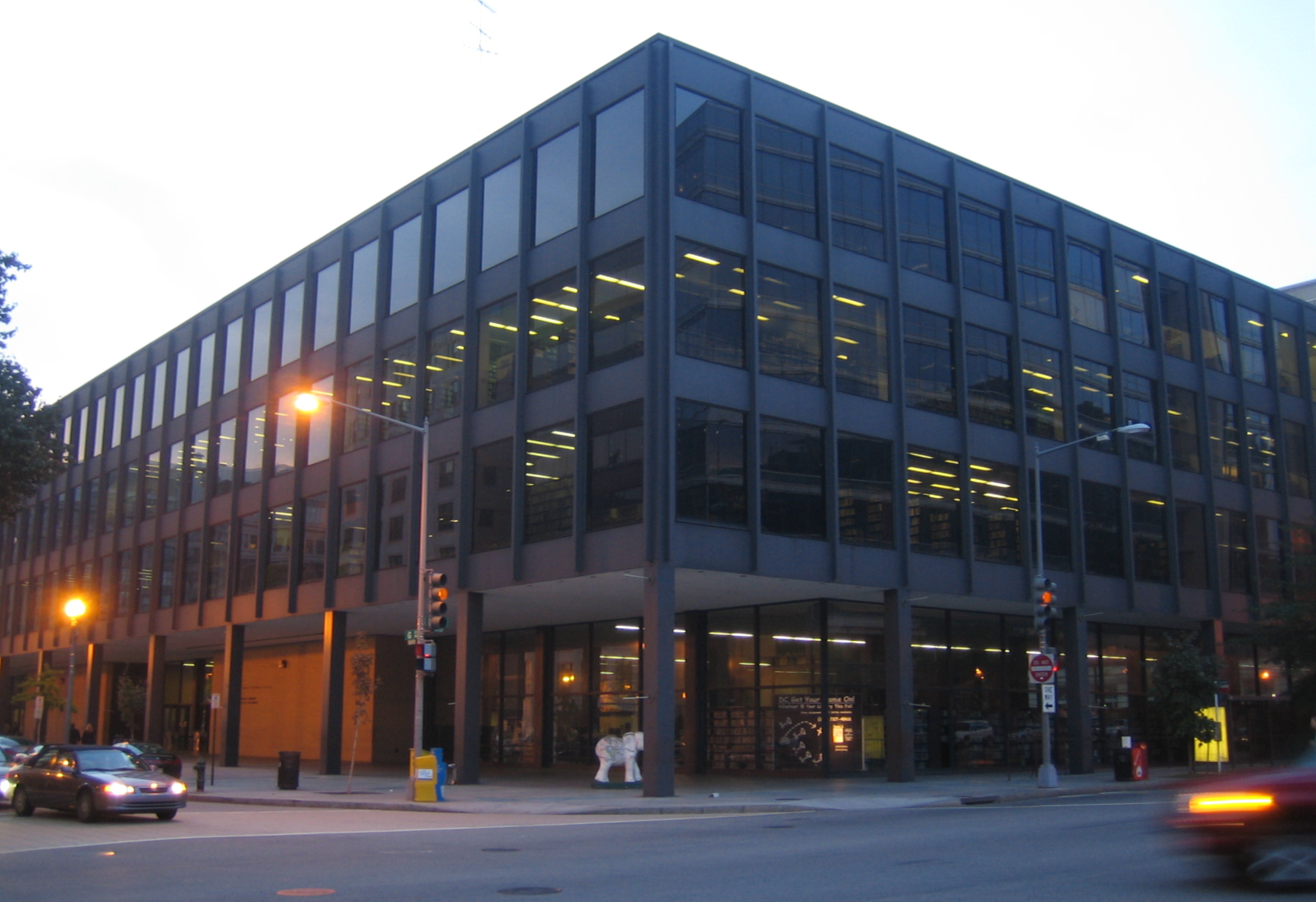
The Martin Luther King Jr. Memorial Library in downtown DC is more than the cornucopia of book stacks it appears to be from the street. Within its glass walls its librarians in various departments labor tirelessly creating programs for multitudes of patrons. Chris is one such librarian. He works with adaptive services teaching the blind how to use computers. This past year a group of students from his advanced class decided to go one step further. Every month or so they meet as a book club and pick a book that doesn’t have a Wikipedia article yet, listen to it, then return and, using the software Chris teaches them how to use, write an article as a group.
It is an amazing privilege to watch them at work. All of them are older folks and have varying amounts of experience with computers but they all take turns typing sentences, navigating the keyboards, counting keys from left to right to find the right letter and clicking it before searching for the next. Everyone participates in the process of writing and brainstorming content and, in the end, what they create is a new Wikipedia entry, expanding the horizon of shared information just that much further.
Their most recent article is about the book Fallen Grace by Mary Hooper and their next project is Outwitting Trolls. To put it in the words of an attendee, “We may get loud and rambunctious, but we pull through. We always pull through.”
Lisa Marrs, Outreach & Program Coordination, Wikimedia DC
Copyright notes: Martin Luther King Jr. Memorial Library in Washington, D.C. by David Monack, licensed under the Creative Commons Attribution-Share Alike 2.5 Generic license from Wikimedia Commons.
]]>